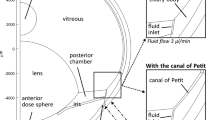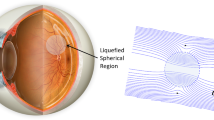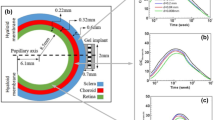Abstract
Purpose. Previous experimental work suggests that convection maybe important in determining the biodistribution of drugs implanted orinjected in the vitreous humor. To develop accurate biodistributionmodels, the relative importance of diffusion and convection inintravitreal transport must be assessed. This requires knowledge of both thediffusivity of candidate drugs and the hydraulic conductivity of thevitreous humor.
Methods. Hydraulic conductivity of cadaveric bovine vitreous humorwas measured by confined compression tests at constant loads of 0.15and 0.2 N and analyzed numerically using a two-phase model. Diffusioncoefficient of acid orange 8, a model compound, in the same mediumwas measured in a custom-built diffusion cell.
Results. Acid orange 8 diffusivity within vitreous humor is about halfthat in free solution. When viscous effects are properly accounted for,the hydraulic conductivity of bovine vitreous humor is 8.4 ± 4.5 ×10−7 cm2/Pa s.
Conclusions. We predict that convection does not contributesignificantly to transport in the mouse eye, particularly forlow-molecular-weight compounds. For delivery to larger animals, such as humanswe conclude that convection accounts for roughly 30% of the totalintravitreal drug transport. This effect should be magnified forhigher-molecular-weight compounds, which diffuse more slowly, and inglaucoma, which involves higher intraocular pressure and thus potentiallyfaster convective flow. Thus, caution should be exercised in theextrapolation of small-animal-model biodistribution data to human scale.
Similar content being viewed by others
REFERENCES
W. M. Hart. Adler's Physiology of the Eye, Mosby-Year Book, Chicago, 1992.
S. C. Pflugfelder, E. Hernandez, S. J. Fliesler, and J. Alvarez. Intravitreal vancomycin. Retinal toxicity, clearance, and interaction with gentamicin. Arch. Ophthalmol. 105:831–837 (1987).
A. Merkli, C. Tabatabay, R. Gurny, and J. Heller. Biodegradable polymers for the controlled release of ocular drugs. Prog. Poly. Sci. 23:563–580 (1998).
C. L. Cottriall, N. A. McBrien, R. Annies, and E. M. Leech. Prevention of form-deprivation myopia with pirenzepine: a study of drug delivery and distribution. Ophthalmic Physiol. Opt. 19:327–335 (1999).
W. H. Stern, G. P. Lewis, P. A. Erickson, C. J. Guerin, D. H. Anderson, S. K. Fisher, and J. J. O'Donnell. Fluorouracil therapy for proliferative vitreoretinopathy After vitrectomy. Am. J. Ophthalmol. 96:33–42 (1983).
Y. Tano, G. Sugita, G. Abrams, and R. Machemer. Inhibition of intraocular proliferations with intravitreal corticosteroids. Am. J. Ophthalmol. 89:131–6 (1980).
Y. Nishimura, H. Hayashi, K. Oshima, and S. Iwata. The diffusion in the bovine vitreous. Acta. Ophthalmol. Jpn. 90:1313–6 (1986).
R. J. Kaiser and D. M. Maurice. The diffusion of fluorescein in the lens. Exp. Eye Res. 3:156–165 (1964).
A. Ohtori and K. J. Toko. In vivo/in vitro correlation of intravitreal delivery of drugs with the help of computer simulation. Biol. Pharm. Bull. 17:283–90 (1994).
S. Tsuboi and J. E. Pederson. Volume flow across the isolated retinal pigment epithelium of cynomulgus monkey eyes. Inv. Ophth. Vis. Sci. 29:1652–5 (1988).
M. Araie and D. Maurice. The loss of flourescein, flourescein glucuronide and flourescein isothiocyanate dextran from the vitreous by the anterior and retinal pathways. Exp. Eye Res. 52: 27–39 (1991).
S. Friedrich, Y. Cheng, and B. Saville. Drug distribution in the vitreous humor of the human eye: the effect of intravitreal injection position and volume. Cur. Eye Res. 16:663–669 (1997).
D. L. Epstein, J. M. Hashimoto, P. J. Anderson, and W. M. Grant. Experimental perfusions through the anterior and vitreous chamber with possible relationships to malignant glaucoma. Am. J. Ophthalmol. 88:1078–86 (1979).
I. Fatt. Flow and diffusion in the vitreous body of the eye. Bull. Math. Biol. 37:85–90 (1975).
D. Maurice. Flow of water between aqueous and vitreous compartments in the rabbit eye. Am. J. Physiol. 252:F104–108 (1987).
S. Tsuboi and J. E. Pederson. Effect of plasma osmolality and intraocular pressure on fluid movement across the blood-retinal barrier. Inv. Ophth. Vis. Sci. 29:1747–9 (1988).
I. Fatt. Hydraulic flow conductivity of the vitreous gel. Inv. Ophth. Vis. Sci. 16:565–568 (1977).
D. M. Knapp, V. H. Barocas, A. G. Moon, K. Yoo, L. R. Petzold, and R. T. Tranquillo. Rheology of reconstituted type I collagen gel in confined compression. J. Rheology 41:971–993 (1997).
L. A. Setton, W. Zhu, and V. C. Mow. The biphasic poroviscoelastic behavior of articular cartilage: role of the surface zone in governing the compressive behavior. J. Biomechanics 26:581–592 (1995).
F. A. Bettelheim and T. J. Y. Wang. Dynamic viscoelastic properties of bovine vitreous. Exp. Eye Res. 23:435–441 (1976).
B. Lee, M. Litt, and G. Buchsbaum. Rheology of the vitreous body: Part 1. Viscoelasticity of human vitreous. Biorheology 31:327–338 (1994).
M. Tokita, Y. Fujiya, and K. Hikichi. Dynamic viscoelasticity of the bovine vitreous. Biorheology 21:751–756 (1984).
V. H. Barocas and R. T. Tranquillo. An anisotropic biphasic theory of tissue-equivalent mechanics: the interplay among cell traction, fibrillar network deformation, fibril alignment, and cell contact guidance. J. Biomech. Eng. 119:137–145 (1997).
M. Dembo and F. Harlow. Cell motion, contractile networks, and the physics of interpenetrating reactive flow. Biophys. J. 50:109–121 (1986).
L. Petzold, J. B. Rosen, P. E. Gill, and K. Park. Numerical optimal control of parabolic PDEs using DASOPT. In L. Biegler, et al., (eds.) Large Scale Optimization with Applications, Part II: Optimal Design and Control, IMA Volumes in Mathematics and its Applications, Springer-Verlag. New York. 1997, pp. 271–300.
C. Geankoplis. Transport Processes and Unit Operation, Prentice Hall. New Jersey, 1983.
S. P. Chen and H. W. Osterhoudt. Diffusion and solubility of some azo dyes in swollen gelatin matrices· the effects of dye size, matrix swell, and dye matrix interactions. J. Appl. Poly. Sci. 30:2075–2094 (1985).
I. Fatt and B. Hedbys. Flow of water in the sclera. Exp. Eye Res. 10:243–249 (1970).
W. G. Robison, T. Kuwabara, and J. Zwaan. Eye research. In H. L. Foster, J. D. Small, and J. G. Fox (eds.), The Mouse in Biomedical Research. Volume IV. Experimental Biology and Oncology, Academic Press. New York. 1982, p. 69–89.
Author information
Authors and Affiliations
Corresponding author
Rights and permissions
About this article
Cite this article
Xu, J., Heys, J.J., Barocas, V.H. et al. Permeability and Diffusion in Vitreous Humor: Implications for Drug Delivery. Pharm Res 17, 664–669 (2000). https://doi.org/10.1023/A:1007517912927
Issue Date:
DOI: https://doi.org/10.1023/A:1007517912927




